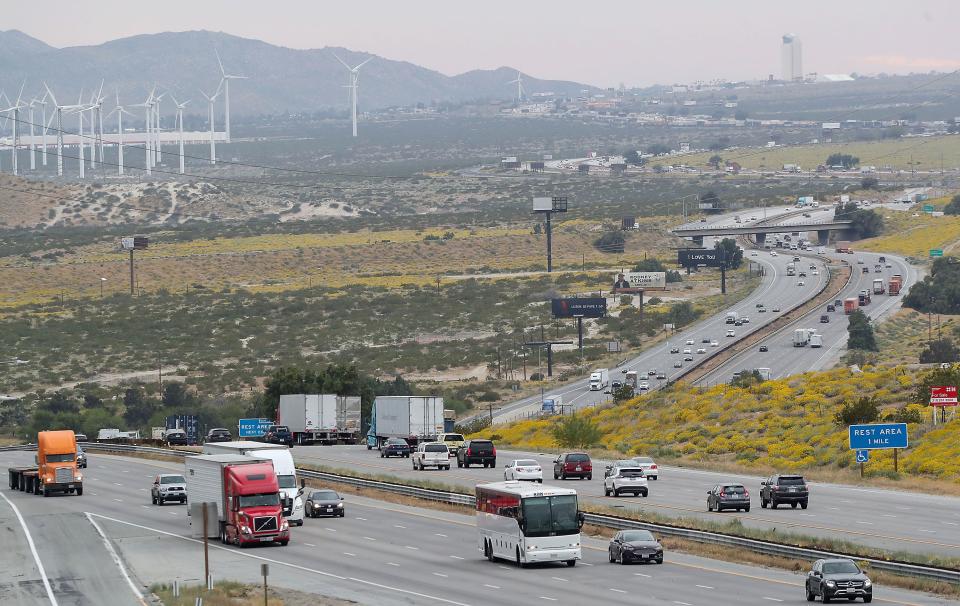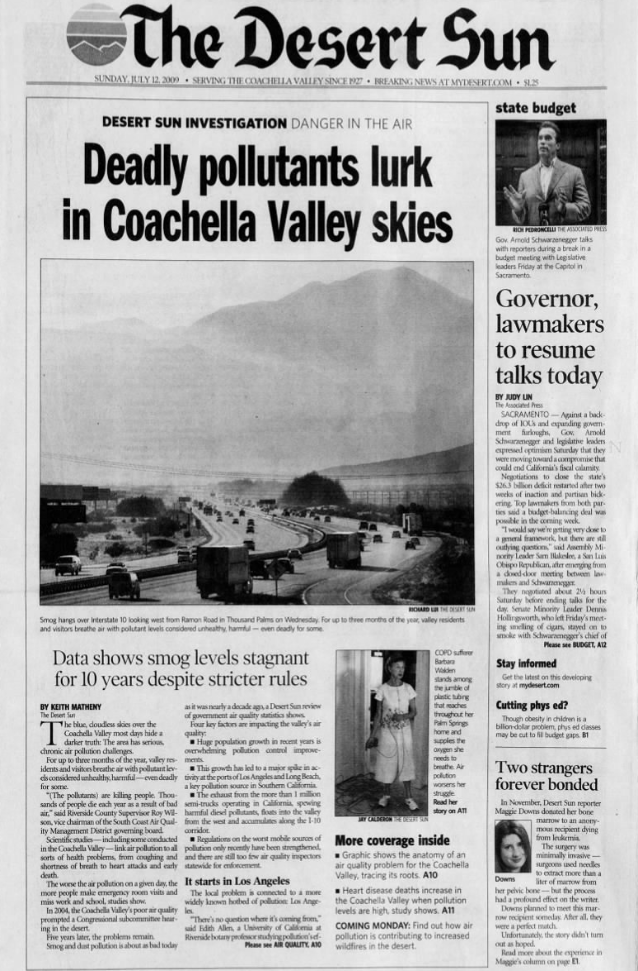Palm Springs could soon become one of the USA's smoggiest destinations

Palm Springs could soon join Los Angeles and the San Joaquin Valley with the dubious distinction of having the smoggiest air in the nation. After spikes in lung-burning air pollution here in the past two years, regional regulators told The Desert Sun this week that they will seek to “bump up” the Coachella Valley’s official ozone status to extreme – the highest federal classification.
Despite efforts to rein in dangerous smog and soot, the eight-hour average for ozone remains stubbornly above legal limits set back in 1997. The request, if approved, would actually allow regulators to slow down the clock to come into compliance with federal clean air laws.
Officials with the South Coast Air Quality Management District, which monitors air from the Los Angeles coast through the desert, say that due to a recent uptick in ozone levels in the Coachella Valley, possibly caused by heat waves and wildfires, they will not be able to meet a June deadline to reduce the pollution here to legal levels. They are seeking another five years to come into compliance.

“We’ve been very successful in ratcheting down emissions,” said Wayne Nastri, executive officer of the district. “When we look at the wildfire conditions and had it not been for the hotter weather, we have every reason to believe we would have been in attainment. ... Our projections show we will meet the levels by 2024."
More: Why climate change is especially dangerous for low-income Coachella Valley residents
More: This city's air is killing people. Who will stop it?
Meanwhile, serious health impacts will continue. Ground-level ozone, more commonly known as smog, is linked to asthma, lung and heart disease. It typically forms on hot summer afternoons, when sunlight hits nitrogen oxides and volatile organic compounds, forming a largely invisible but dangerous blanket. Health problems can be aggravated on smoggy days, resulting in thousands of lost school and work days, increased hospitalizations and deaths.
"Ground-level ozone, you can think of it as a corrosive gas. It burns lung tissue like a bad sunburn on the skin," said Will Barrett, California director of clean air advocacy with the American Lung Association. "It damages your respiratory tract, it creates coughing, tightness in the chest, shortness of breath ... but it can also contribute to asthma, lung disease, heart attacks and premature death."
Children with growing lungs, the elderly and others with existing health conditions and people who work outdoors are all at higher risk. Ideally, work hours should be shifted and sensitive populations should stay indoors on high pollution days, he said.

Pollution from Los Angeles blown inland is the main culprit, particularly from trucks, cars, trains and freighter ships. There are also nine facilities in the Coachella Valley that either have permits to emit ozone-forming ingredients or which may need to obtain them, including power producers and hospitals that use backup diesel equipment.
The Coachella Valley has been “out of attainment” with ground-level ozone limits since the cap was set in 1997. In 2003, levels reached 108 parts per billion. That doesn’t sound like much, but research has linked serious health problems to levels as low as 60 parts per billion. Decades later, while overall air quality is better, the problem persists.
The pollution has been fed by explosive population growth coupled with geography, possibly topped by increasing climate change. An arc of mountains stretching south from Santa Barbara to northern San Diego County has only one main opening – the San Gorgonio Pass. That funnels a stew of nitrogen oxides, volatile organic compounds and other emissions across the Coachella Valley – more than 80% from commuter and freight traffic emissions out of Los Angeles, and another 10% from more than 270 refineries, power plants and factories there. The rest comes from a variety of smaller sources, including gas-fueled home heaters, hot water tanks and common household cleaning supplies.
"To paraphrase Bob Dylan, the answer is blowing in the wind," said UC Irvine atmospheric physicist Charlie Zender, who studies air pollution transport.
As for the request to designate the Coachella Valley as having extreme ozone levels, joining only Los Angeles and the San Joaquin Valley, he said, "That’s something you don't want to be number one or two in."
More: Air quality funds attached to CV Link have now been spent – with one big exception
More: Gallery: Mexican industries pollute air near US border
But he added, "I'm actually surprised it's taken this long because the area sits at the receiving end of an atmospheric river of pollution with westerly winds blowing most of the year. That's the dominant circulation year-round."
Desert conditions don't help. Scorching temperatures press down on cooler air, forming inversions that trap the contaminants at breathing level. Plants also suffer in area national parks, forests and household gardens.
"You can actually see scarring due to ozone, it's visible, splotchy, gray areas on leaves, just like pictures of a smoker's lungs," said Zender.
Air district officials said climate change could be playing a role, which Nastri said could “require us to redouble our efforts even more.”
But he stressed the air has improved. Beginning in 2003, the amount of ozone detected in Coachella Valley area air declined fairly steadily, reaching a low of 87 parts per billion in 2016, bringing the amounts tantalizing close to the legal limit of 80 to 84 parts per billion. AQMD deputy executive officer Philip Fine said at that point, three years out, they thought they were on track to meet the deadline.
But in the past two years, the amounts started to tick upward again, to 88 parts per billion in 2017 and 92 parts per billion in 2018. Ozone levels have risen slightly across the West over the past two years, as temperatures have climbed. Both were predicted by climate change researchers, though the link is still being explored. The district is commissioning a study to see if global warming contributed to the latest spike.
More: A summer of smog: Southern California endures 87 consecutive days of dirty air
Last year was the hottest ever in the Palm Springs area, according to federal data. The Coachella Valley was the only site in the United States that experienced its highest average temperature in 2018, according to data collected by the National Oceanic and Atmospheric Administration. The Holy Fire and Cranston fires also released toxins in heavy smoke.
Locally, five entities could face new permit requirements to be allowed to emit ozone-forming chemicals. Any large facility that uses a combustion engine or diesel equipment can be subject to permits.
Barrett with the lung association said port and warehouse distribution sites that draw large amounts of trucks, like those that have been built along the Interstate 10 freeway, also contribute to smog.
Agricultural operations are largely exempt from ozone regulations across the U.S., including here. But AQMD officials have met with and are researching the emissions of cannabis industry processors, saying the chemical reactions they create could contribute to ozone.
Zender said he thinks it would continue to be tough to meet legal levels in coming years, both because of climate change, and because "that area of the desert has just grown enormously because of the housing need. So Coachella has to fight the battle for those clean air standards against the demographic tide of becoming a densely populated region."
This article originally appeared on Palm Springs Desert Sun: Palm Springs could soon become one of the USA's smoggiest destinations

